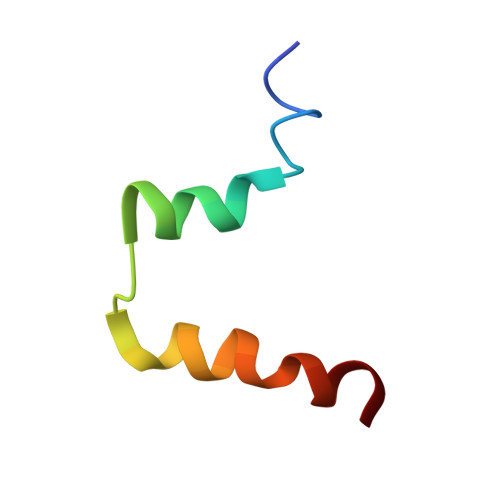Structure-Related Roles for the Conservation of the HIV-1 Fusion Peptide Sequence Revealed by Nuclear Magnetic Resonance.
Serrano, S., Huarte, N., Rujas, E., Andreu, D., Nieva, J.L., Jimenez, M.A.(2017) Biochemistry 56: 5503-5511
- PubMed: 28930470
- DOI: https://doi.org/10.1021/acs.biochem.7b00745
- Primary Citation of Related Structures:
5NVP, 5NWU, 5NWV, 5NWW - PubMed Abstract:
Despite extensive characterization of the human immunodeficiency virus type 1 (HIV-1) hydrophobic fusion peptide (FP), the structure-function relationships underlying its extraordinary degree of conservation remain poorly understood. Specifically, the fact that the tandem repeat of the FLGFLG tripeptide is absolutely conserved suggests that high hydrophobicity may not suffice to unleash FP function. Here, we have compared the nuclear magnetic resonance (NMR) structures adopted in nonpolar media by two FP surrogates, wtFP-tag and scrFP-tag, which had equal hydrophobicity but contained wild-type and scrambled core sequences LFLGFLG and FGLLGFL, respectively. In addition, these peptides were tagged at their C-termini with an epitope sequence that folded independently, thereby allowing Western blot detection without interfering with FP structure. We observed similar α-helical FP conformations for both specimens dissolved in the low-polarity medium 25% (v/v) 1,1,1,3,3,3-hexafluoro-2-propanol (HFIP), but important differences in contact with micelles of the membrane mimetic dodecylphosphocholine (DPC). Thus, whereas wtFP-tag preserved a helix displaying a Gly-rich ridge, the scrambled sequence lost in great part the helical structure upon being solubilized in DPC. Western blot analyses further revealed the capacity of wtFP-tag to assemble trimers in membranes, whereas membrane oligomers were not observed in the case of the scrFP-tag sequence. We conclude that, beyond hydrophobicity, preserving sequence order is an important feature for defining the secondary structures and oligomeric states adopted by the HIV FP in membranes.
Organizational Affiliation:
Institute of Physical Chemistry "Rocasolano" (IQFR-CSIC) , Serrano 119, E-28006 Madrid, Spain.














